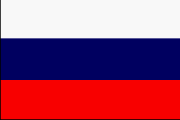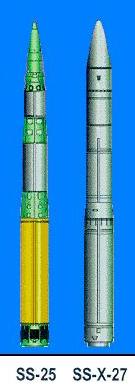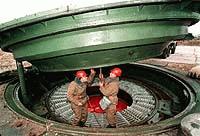





 The single-warhead RT-2UTTH Topol-M is an advanced version of the silo-based and mobile Topol intercontinental ballistic missile. The SS-25 Topol is generally similar to the American Minuteman-2, while the more sophisticated SS-27 Topol-M is comparable to the American Minuteman-3. The Topol-M is 22.7 meters (75 feet) long and has a diameter of 1.95 meters (6 feet 3 inches). The missile weighs 47.2 metric tons and has a range of 11,000 kilometers (6,900 miles). The solid-propellant three-stage Topol-M missile complex, with a standardized (silo and mobile) missile, is to become the foundation of the Russian strategic nuclear forces in the 21st century. It is planned to accommodate Topol-M both on self-propelled launchers as well as in silos. High survivability of the mobile complex is achieved by the capability of offroad movement, of a continuous change in location and of a missile launch from any point along the movement route.
The Moscow Institute of Heat Engineering (MIT) State Enterprise is the only plant in Russia building such missiles today. The modernized 45-ton Topol-M is the first strategic missile to be built by Russia without the participation of Ukraine and CIS countries. The first test firing of a Topol-M took place on December 20, 1994. The flight and design testing of the Topol-M was successfully completed in 1995, and joint flight-testing is continuing, leading to a decision to commence series production. All the launches have been a success, but large-scale serial production has not started due to a shortage of funds. On 08 July 1997 the fourth launch of a Topol-M ICBM was successfully made from the Strategic Missile Forces' Plesetsk State Test Site within the framework of joint flight-testing. The eighth test of the Topol-M missile was conducted on 03 September 1999. The missile was launched from Plesetsk, north of Moscow, and landed at the Kura testing site on Kamchatka. On 10 February 2000 Russia successfully completed the tenth test flight of the Topol-M. The missile was launched from the Plesetsk cosmodrome to a target at the military base in Kura, on the Kamchatka peninsula in the Russian far east, 8,000 kilometers away. On 27 September 2000 Russia test-fired another Topol-M, sending the SS-27 on a 4,000-mile flight from the Arctic base of Plesetsk in northern Russia to its intended target in the Russian Far East. In this 12th test, the missile was fired from a mobile launcher, rather than from a silo. It was the second SS-27 missile test in two days.
The single-warhead RT-2UTTH Topol-M is an advanced version of the silo-based and mobile Topol intercontinental ballistic missile. The SS-25 Topol is generally similar to the American Minuteman-2, while the more sophisticated SS-27 Topol-M is comparable to the American Minuteman-3. The Topol-M is 22.7 meters (75 feet) long and has a diameter of 1.95 meters (6 feet 3 inches). The missile weighs 47.2 metric tons and has a range of 11,000 kilometers (6,900 miles). The solid-propellant three-stage Topol-M missile complex, with a standardized (silo and mobile) missile, is to become the foundation of the Russian strategic nuclear forces in the 21st century. It is planned to accommodate Topol-M both on self-propelled launchers as well as in silos. High survivability of the mobile complex is achieved by the capability of offroad movement, of a continuous change in location and of a missile launch from any point along the movement route.
The Moscow Institute of Heat Engineering (MIT) State Enterprise is the only plant in Russia building such missiles today. The modernized 45-ton Topol-M is the first strategic missile to be built by Russia without the participation of Ukraine and CIS countries. The first test firing of a Topol-M took place on December 20, 1994. The flight and design testing of the Topol-M was successfully completed in 1995, and joint flight-testing is continuing, leading to a decision to commence series production. All the launches have been a success, but large-scale serial production has not started due to a shortage of funds. On 08 July 1997 the fourth launch of a Topol-M ICBM was successfully made from the Strategic Missile Forces' Plesetsk State Test Site within the framework of joint flight-testing. The eighth test of the Topol-M missile was conducted on 03 September 1999. The missile was launched from Plesetsk, north of Moscow, and landed at the Kura testing site on Kamchatka. On 10 February 2000 Russia successfully completed the tenth test flight of the Topol-M. The missile was launched from the Plesetsk cosmodrome to a target at the military base in Kura, on the Kamchatka peninsula in the Russian far east, 8,000 kilometers away. On 27 September 2000 Russia test-fired another Topol-M, sending the SS-27 on a 4,000-mile flight from the Arctic base of Plesetsk in northern Russia to its intended target in the Russian Far East. In this 12th test, the missile was fired from a mobile launcher, rather than from a silo. It was the second SS-27 missile test in two days. 
Work on the new Topol-M ICBM is lagging seriously behind the initial timetable. Defense state order financing for the next decade provides that by 2003 there will be on the order of 250-300 Topol-M missiles in service. A total of 1.5 trillion [old] rubles were included in the 1997 budget for the development of the Topol-M missile complex. The Russian Missile Troops are permitted to have 300 Topol RS-12M mobile missiles under the START II Treaty, and the RVSN must acquire two Topol-M regiments annually up to 2001, which will cost 3.7 billion new rubles. The Strategic Missile Force plans to deploy mobile Topol-M missile systems at the end of 2002 or early in 2003. A total of R700 billion would be required to place 450 Topol-M missiles in service by 2005 to maintain parity under START II. But the present 55 percent funding will permit production of at the very most 10-15 missiles at this facility each year year. As a result the Strategic Missile Troops would have a total of approximately 350-400 ICBM warheads, not the 800-900 which are permited within the framework of the START II Treaty. On 15 April 1998 Acting Prime Minister Sergey Kiriyenko approved a schedule of monthly budget appropriations for the Topol-M, which he noted would make up the core of Russia's strategic nuclear forces.
In December 1997 after four test launches, the first two Topol-M systems were put on alert for a trial period with the Taman Division at Tatischevo in the Saratov region. As of late July 1998 two more Topol-M launch sites were completed and were awaiting acceptance trials. Russia put a regiment of 10 Topol-M missiles on duty in 1998. By that time the Strategic Rocket Forces had carried out 6 successful test launches. A second regiment of another 10 missiles entered service in December 1999. A third regiment, of 10 Topol-M missiles will be deployed in 2000.
The Topol-M missile system is being commissioned in the Russian strategic nuclear forces' grouping regardless of whether heavy missiles are stood down from combat alert duty or not. It is intended that the Topol-M ICBM grouping will comprise an equal number of mobile and silo-launched missiles. Some 90 of the 360 launch silos vacated by the RS-20 ICBM's, which are being stood down from combat alert duty, need to be converted for the latter. Apart from Saratov Oblast the Topol-M systems will be deployed in Valday, the southern Urals, and the Altay.
The START II strategic arms reduction treaty, signed with the United States in 1993 but not yet ratified by Russia's parliament, calls for Russia to replace its SS-18 missiles, which have multiple warheads, with single warhead missiles such as the Topol-M. Although deployed with a single warhead, the Topol-M could be converted into a multiple-warhead missile, which was prohibited by the START II treaty. Topol-M could carry at least three and perhaps as many as six warheads. The Topol-M missiles could be transformed into missiles with multiple reentry vehicles [MIRV's], since their throw weight allows accommodating 3-4 warheads on a missile. The warheads could be taken from some of those ground-based and naval missiles which will be withdrawn from the order of battle in coming years. The Topol-M can carry a maneuverable warhead, which was tested in the summer of 1998. Topol-M also has a shorter engine-burn time, to minimize satellite detection on launch.Specifications | ||||
|
DIA |
SS-27, SS-X-29, SS-25B |
|||
|
NATO |
||||
|
Bilateral |
RS-12M2 |
|||
|
Service |
RT-2PM2, RT-2PM-OS |
|||
|
OKB/Industry |
15Zh?? |
|||
|
Design Bureau |
(MIT)Moscow Institute of Thermal Technology |
|||
|
Approved |
2/ /1993 |
|||
|
Years of R&D |
1993 - 1997 |
|||
|
Engineering and Testing |
1994 - 1997 |
|||
|
First Flight Test |
12/20/94 |
|||
|
IOC |
1997 |
|||
|
Deployment Date |
12/27/1997 |
|||
|
Type of Warhead |
Single |
|||
|
Warheads |
1 |
|||
|
Yield (Mt) |
||||
|
Payload (kg) |
1,000 - 1,200 |
|||
|
Total length (m) |
21.0 - 22.7 |
|||
|
Total length w/o warhead (m) |
17.9 |
|||
|
Missile Diameter (m) |
1.86 - 1.95 |
|||
|
Launch Weight (t) |
47.2 - 47.21 |
|||
|
Fuel Weight (t) |
||||
|
Range (km) |
10,000 -10,500 |
|||
|
CEP (m) (Russian Sources) |
||||
|
CEP (m) (Western Sources) |
350+ |
|||
|
Number of Stages |
3 |
|
Canister length (m) |
21,2 - 23.0 |
|
Canister length w/o front meters (m) |
19.44 |
|
Canister diameter (m) |
2.0 |
|
Booster guidance system |
Inertial, autonomous |
|
1st stage |
2nd stage |
3rd stage |
4th. BUS |
|
|
Length (m) |
8.04? |
|||
|
Body diameter (m) |
1.86 - 1.95 |
1.61 |
1.58 |
|
|
Fueled weight (t) |
28.6 |
|||
|
Dry weight (t) |
||||
|
Design Bureau for the Solid Motors |
MIT, NPO Soyuz |
MIT, NPO Soyuz |
MIT, NPO Soyuz |
|
|
Engine Designation |
||||
|
Propellants |
Solid Propellant |
Solid Propellant |
Solid Propellant |
|
|
Burning time (s) |
||||
|
Solid Motor Thrust Sea Level/Vacuum (Tonnes) |
||||
|
Specific Impulse (m/s) |
|
Basing Mode |
Silo/Ground mobile |
|
Hardness |
|
|
Launching Technique |
|
|
Deployed boosters |
|
|
Test Boosters |
|
|
Warheads Deployed |
|
|
Deployment Sites |
|
|
Training Launchers |
|
|
Space Booster Variant |
No |
